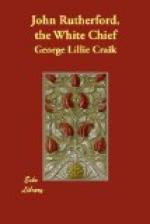FOOTNOTES:
[Footnote AO: Craik is correct in this surmise. The Maori dog, Canis familiaris, (Variety Maorium), which is now extinct, was introduced to New Zealand when the Maoris came at the time of their great migration, about 500 years ago.]
[Footnote AP: The alligator is purely mythical. The only reptiles in New Zealand are lizards, and a lizard-like animal called Tuatara. It is about 18 inches long, and is allied to crocodiles and turtles, as well as lizards. It is the sole representative of an ancient reptilian order named Rhyncocephalia.]
[Footnote AQ: This is the bell-bird (Anthornis melanura).]
[Footnote AR: The tui, or parson bird (Prosthemadera novae zealandiae.)]
[Footnote AS: Large numbers of New Zealand birds unite in the spring in singing a magnificent Song of Dawn, which generally ceases when the sun has fairly risen, but individuals sing at intervals through the day.]
CHAPTER VII.
The details we have thus given will enable the reader to form a conception of the state of society in the country in which Rutherford now found himself imprisoned.
The spot in the northern island of New Zealand, in which the village lay where his residence was eventually fixed, cannot be exactly ascertained, from the account which he gives of his journey to it from the coast. It is evident, however, from the narrative, that it was too far in the interior to permit the sea to be seen from it.
“For the first year after our arrival in Aimy’s village,” says Rutherford, “we spent our time chiefly in fishing and shooting; for the chief had a capital double-barrelled fowling piece, as well as plenty of powder and duck-shot, which he had brought from our vessel; and he used to entrust me with the fowling-piece whenever I had a mind to go a shooting, though he seldom accompanied me himself. We were generally fortunate enough to bring home a good many wood-pigeons, which are very plentiful in New Zealand.
“At last it happened that Aimy and his family went to a feast at another village a few miles distant from ours, and my comrade and I were left at home, with nobody but a few slaves, and the chief’s mother, an old woman, who was sick, and attended by a physician. A physician in this country remains with his patients constantly both day and night, never leaving them till they either recover or die, in which latter case he is brought before a court of inquiry, composed of all the chiefs for many miles round.
“During the absence of the family at the feast, my comrade chanced to lend his knife to a slave for him to cut some rushes with, in order to repair a house; and when this was done he received it back again. Soon after he and I killed a pig, from which we cut a portion into small pieces, and put them into our iron pot, along with some potatoes which we had also peeled with our knives. When the potatoes were cooked, the old woman who was sick desired us to give her some, which we did in the presence of the doctor, and she ate them. Next morning she died, when the chief and the rest of his family immediately returned home.




